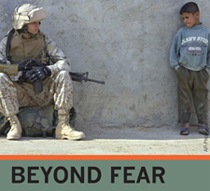We entrust this momentous task to Rima Snyder of Red Wagon Audio.
Like Larry Josephson, Rima works from the comfort of her home. Her Culver City, California house was built on what used to be the back lot of MGM Studios, so it somehow seems fitting that the final mix happens in the shadows of Hollywood.
There are dozens of people who could engineer the final mix, but why fix something when it isn’t broken? Rima has worked the past six Stanley Foundation/KQED radio specials. My ProTools skills aren’t too shabby, but Rima is a PT whiz.
With Rima’s trusty dog Willa at our feet, Rima works her magic as I offer up direction, suggestions and comments.
It doesn’t take long to reach the point every producer dreads: trimming the script to fit the clock. I long for the day when I can honestly say we added material to a show!
We successfully hit the magic time of 52:59 today. It will take us a few more days to “polish” up the final product. Anxious to hear the final result? Beyond Fear: America’s Role in an Uncertain World debuts on KQED Public Radio on May 9 at 8:00pm PDT. National distribution begins the next day.
--Kristin McHugh







